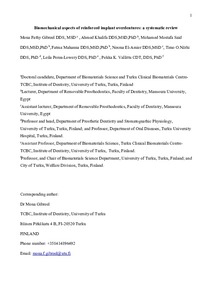Biomechanical aspects of reinforced implant over-dentures: a systematic review
Timo O. Närhi; Mohamed Moustafa Said; Leila Perea-Lowery; Pekka K. Vallittu; Ahmed Khalifa; Nesma El-Amier; Mona Fathy Gibreel; Fatma Mahanna
https://urn.fi/URN:NBN:fi-fe2021042823842
Tiivistelmä
Abstract
Purpose
The purpose of this systematic review was to investigate the effect of reinforcement on the mechanical behaviour of implant overdenture (IOD) bases and its cumulative biological effect on the underlying supporting structures (implants and the residual ridge).
Material and methods
The required documents were collected electronically from PubMed and Web of Science databases targeting papers published in English that focused on denture base reinforcement for IOD prostheses in order to recognize the principal outcomes of reinforcement on the mechanical and biological properties of overdentures. Such biological outcomes as: strains on implants, peri-implant bone loss, residual ridge resorption, and strain on the residual alveolar ridge.
Results
A total of 269 citations were identified. After excluding any repeated articles between databases and the application of exclusion and inclusion criteria, only 13 publications fulfilled the inclusion criteria. Three publications investigated the mechanical properties of fibre and/or metal-reinforced implant overdentures while another 3 articles investigated the effect of metal reinforcement on stress distribution and strains transmitted to the underlying implants. In addition, 3 in vitro studies investigated the effect of metal reinforcement on overdenture base strain and stresses. Stress distribution to the residual ridge and strain characteristics of the underlying tissues were investigated by 2 in vitro studies. Five clinical studies performed to assist the clinical and prosthetic maintenance of metal-reinforced IOD were included. Data concerning denture base fracture, relining, peri-implant bone loss, probing depth, and implant survival rates during the functional period were extracted and considered in order to evaluate the mechanical properties of the denture base, residual ridge resorption and implant preservation rates, respectively.
Conclusion
The use of a denture base reinforcement can reduce the fracture incidence in IOD bases by enhancing their flexural properties and reducing the overdenture base deformation. Strains on the underlying supporting structures of overdenture prostheses including dental implants and the residual ridge can be decreased and evenly distributed using a metal reinforcement.
Kokoelmat
- Rinnakkaistallenteet [19207]
